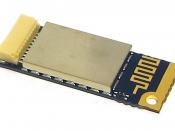With the drastic increase in new technology this past century, I am sure that many people have pondered the question: "I wonder what new technology is going to be part of our lives in the next 10 years or so?". Wireless communications is the one particular technology that has always fascinated me. The convenience and mass usage of cordless phones, cell phones, wireless networking, GPS or navigation systems have always captured my attention.
A few years ago I first heard of the name Bluetooth . Along with the interesting name, a "futuristic" scenario was embossed in my memory whereby a cell phone would communicate with one's fridge at home and then notify the owner that the milk-supply was running low. This may seem a little far-fetched but it may very well be a reality and a standard in a few decades. Bluetooth's primary purpose is to enable short-range wireless voice and data communications anywhere in the world.
The way Bluetooth actually works by allowing users to connect to a wide range of telecommunication and computer devices without cables, namely mobile phones, portable computers, personal handheld devices, as well as connection to the Internet (bluetooth.com, 'how it works'). In the following, I will further explain what, how and where Bluetooth works and what the potential use of this new technology is.
The Bluetooth name comes from a Scandinavian king Harald Blatand, where "Blatand" is translated to "Blue Tooth" (Miller Michael, page 26). This king was known for uniting countries just as the Bluetooth technology is intended to unite countries with its open specification . There were five founding companies of the Bluetooth Special Interest Group (SIG): Ericsson, Intel Corporation, IBM, Nokia Corporation and Toshiba Corporation. These companies formed the core group known as the "promoter" companies of the Bluetooth specification...


